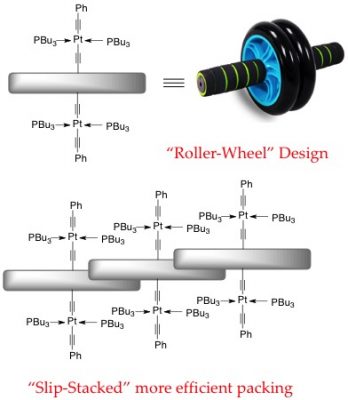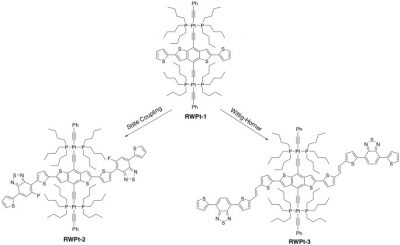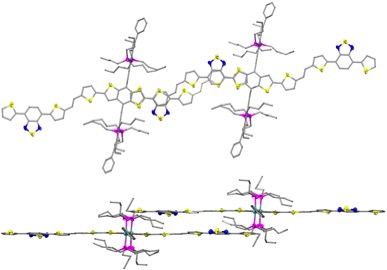Incorporation of transition metals into conjugated structures has been widely applied as an intriguing strategy to give organic materials with novel properties characteristic to metals. Among various transition metal complexes, those of Pt(II) are unique because they intrinsically adopt square planar geometries and can serve as building blocks for linear long-chain structures. These complexes typically show strong spin-orbit coupling effects that induce facile formation of long-lived triplet excitons, which have been considered beneficial for organic photovoltaic (OPV) operations. Consequently, Pt-containing conjugated polymers (CPs) have recently attracted significant attention in OPV research. A variety of CPs containing Pt(II)-bisacetylide building blocks have been prepared and studied in detail. However, except for a handful of examples showing reasonable device performances up to ca. 4% power conversion efficiencies (PCEs), most of the Pt-containing polymers performed very poorly. We have devised a new structural design motif for Pt-bisacetylide containing materials, namely “roller-wheel” shaped molecules, in contrast to the “dumbbell” type geometries in traditional Pt-containing small molecules and polymers. We have prepared a series of such “roller-wheel” complexes having an identical Pt-containing core (the “wheel”) and different conjugated arms (the “roller”). It was revealed that if the “rollers” are long enough, these molecules can “slip-stack” in the solid state, leading to high crystallinity and charge mobility. OPV devices were fabricated and showed power conversion efficiencies up to 5.9%, out-performing all existing Pt-containing materials. These materials generate long-lived triplet excitons that are mostly dark and not converted to electricity in the current device setup. We thus applied transient absorption studies using different electron acceptors to estimate the triplet energy levels, which shed light on how to capture triplet excitons in OPV devices, a rarely investigated mechanism that can potentially improve device performance.



Representative Publications.
“‘Roller-Wheel’ Pt-Containing Small Molecules and the Impact of ‘Rollers’ on Material Crystallinity, Electronic Properties and Solar Cell Performance.” He, W.; Livshits, M. Y.; Dickie, D.; Zhang, Z.; Mejiaortega, L. E.#; Rack, J. J.*; Wu, Q.* and Qin Y.* J. Am. Chem. Soc. 2017, 139, 14109-14119. Link to Article
“A ‘Roller-Wheel’ Pt-Containing Small Molecule that Outperforms Its Polymer Analogs in Organic Solar Cells.” He, W.; Livshits, M. Y.; Dickie, D.; Yang, J.; Quinnett, R.#; Rack, J. J.; Wu, Q. and Qin Y.* Chem. Sci. 2016, 7, 5798-5804. Link to Article
“Synthesis and Photovoltaic Properties of a Low Bandgap BODIPY–Pt Conjugated Polymer.” He, W.; Jiang, Y.; Qin, Y.* Polym. Chem.2014, 5, 1298-1304. Link to Article